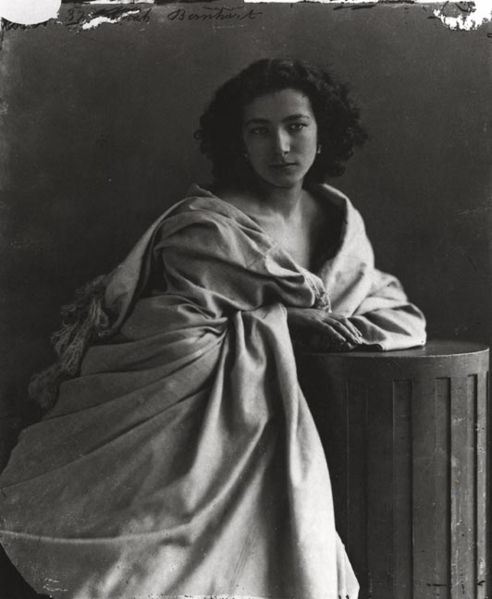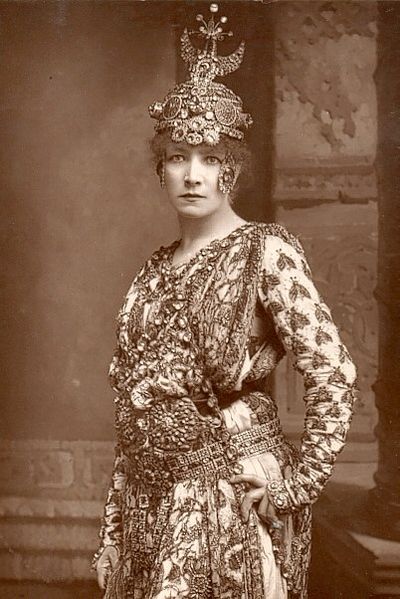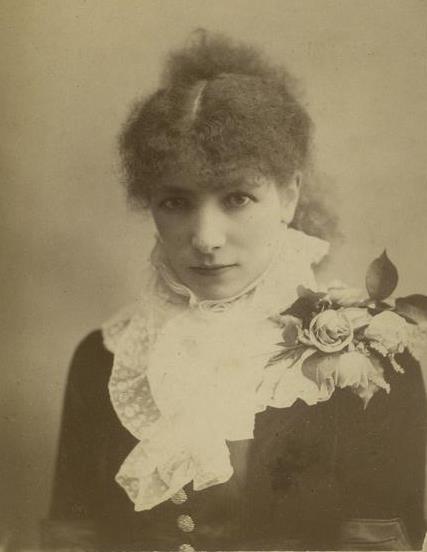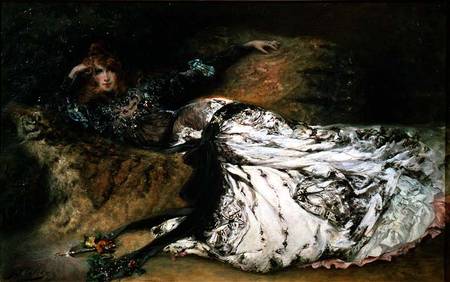<Back to Index>
- Mathematician Alexander Semenovich Kronrod, 1921
- Actress Sarah Bernhardt, 1844
- King of Portugal and the Algarves John V, 1689
PAGE SPONSOR



Sarah Bernhardt (c. October 22, 1844 – March 26, 1923) was a French stage and early film actress, and has been referred to as "the most famous actress the world has ever known". Bernhardt made her fame on the stages of France in the 1870s, and was soon in demand in Europe and the Americas. She developed a reputation as a serious dramatic actress, earning the nickname "The Divine Sarah".
Bernhardt was born in Paris as Rosine Bernardt, the daughter of Julie Bernardt (1821, Amsterdam – 1876, Paris) and an unknown father. Julie was one of six children of a widely traveling Jewish spectacle merchant, "vision specialist" and petty criminal Moritz Baruch Bernardt, and Sara Hirsch (later known as Janetta Hartog) (ca 1797 – 1829). Julie's father remarried Sara Kinsbergen (1809 – 1878) two weeks after his first wife's death, and abandoned his family in 1835. Julie left for Paris, where she made a living as a courtesan and was known by the name "Youle". Sarah would add the letter "H" to both her first and last name. Sarah's birth records were lost in a fire in 1871, but in order to prove French citizenship, necessary for Légion d'honneur eligibility, she created false birth records, on which she was the daughter of "Judith van Hard" and "Edouard Bernardt" from Le Havre, in later stories either a law student, accountant, naval cadet or naval officer.
As the presence of a baby interfered with her mother Julie's terrible and stressful life, Sarah was brought up in a pension, and later in a convent. A child of delicate health, she considered becoming a nun, but one of her mother's reputed lovers – the future Duc de Morny,Napoleon III's half-brother – decided that Sarah should be an actress. When she was 13, le Duc de Morny arranged for her to enter the Conservatoire, the government sponsored school of acting. She was not considered a particularly promising student, and, although she revered some of her teachers, she regarded the Conservatoire's methods as antiquated and too deeply steeped in tradition. Much of the uncertainty about Bernhardt's life arises because of her tendency to exaggerate and distort. Alexandre Dumas, fils described her as a notorious liar.
Sarah Bernhardt left the Conservatoire in 1862, and, thanks to the Duc de Morny‘s influence, was accepted by the national theatre company, the Comédie - Française, as a beginner on probation. During the obligatory three debuts required of probationers, her talents were scarcely noticed by critics. Her contract with Comédie - Française was canceled in 1863 after she slapped the face of a senior actress who had been rude to her younger sister.
For
a time she found employment at the Théâtre du
Gymnase - Dramatique where she was given the part of a silly Russian
princess, further compromising her already volatile reputation. She
decided to leave France, and soon ended up in Belgium, where she became
the mistress of Henri, Prince de Ligne, and gave birth to their son,
Maurice, in 1864. After Maurice's birth, the Prince proposed marriage,
but his family forbade it and convinced Bernhardt to refuse and end
their relationship.
In 1866 she signed a contract with Odéon Theatre in
Paris. During six years of intensive work with a congenial company
there, she gradually established her reputation. Her first success was
as Anna Damby in the 1868 revival of Kean (by the novelist and playwright Alexandre Dumas père).
Bernhardt’s greatest triumph at the Odéon, however, came in 1869
when she portrayed the minstrel Zanetto in the one - act verse play Le Passant (“The
Passerby”) by the young dramatist François Coppée, a part
that she played again in a command performance before Napoleon III.
During
this time that she acquired her famous coffin, in which she often slept
in lieu of a bed – claiming that doing so helped her understand her
many tragic roles. She made her fame on the stages of Europe in the
1870s, and was soon in demand all over Europe and in New York. She
developed a reputation as a serious dramatic actress, earning the title
"The Divine Sarah"; arguably, she was the most famous actress of the
19th century.
During the Franco - Prussian War in 1870, she organized a military hospital in the Odéon. After the war, the reopened Odéon paid tribute to the 19th century writer Victor Hugo with a production of his verse-play Ruy Blas. As Queen Maria, Bernhardt charmed her audiences with lyrical quality of her voice. It was then that Hugo coined the phrase “golden voice,” though her critics usually called her voice “silvery” – as resembling the tone of a flute. In 1872 she left the Odéon and returned to Comédie - Française. One of her remarkable successes there was in the title role of Voltaire's Zaïre (1874). She even traveled to Cuba and performed in the Sauto Theater, in Matanzas, in 1887. She coached many young women in the art of acting, including actress and courtesan Liane de Pougy.
Bernhardt had an affair with a Belgian nobleman, Charles - Joseph Eugène Henri Georges Lamoral de Ligne (1837 – 1914), son of Eugène, 8th Prince of Ligne, with whom she had her only child, Maurice Bernhardt, in 1864. He married a Polish princess, Maria Jablonowska.
Sarah's close friends would include several artists, most notably Gustave Doré and Georges Clairin, and actors Mounet - Sully and Lou Tellegen, as well as the famous French author Victor Hugo. Alphonse Mucha based several of his iconic Art Nouveau works on her. Her friendship with Louise Abbéma (1853 – 1927), a French impressionist painter,
some nine years her junior, was so close and passionate that the two
women were rumored to be lovers. In 1990, a painting by Abbéma,
depicting the two on a boat ride on the lake in the bois de Boulogne,
was donated to the Comédie - Française. The accompanying letter stated that the painting was "Peint par Louise Abbéma, le jour anniversaire de leur liaison amoureuse."
She later married Greek born actor Aristides Damala (known in France by the stage name
Jacques Damala) in London in 1882, but the marriage, which legally endured until Damala's death in 1889 at age 34, quickly collapsed, largely due to Damala's dependence on morphine. During the later years of this marriage, Bernhardt was said to have been involved in an affair with the Prince of Wales, who later became Edward VII.Bernhardt once stated, "Me pray? Never! I'm an atheist." However, she had been baptised a Roman Catholic, and accepted the last rites shortly before her death.
Bernhardt was one of the pioneer silent movie actresses, debuting as Hamlet in the two minute long film Le Duel d'Hamlet in 1900 (Technically, this was not a silent film, as it had an accompanying Edison cylinder with sound effects). She went on to star in eight motion pictures and two biographical films in all. The latter included Sarah Bernhardt à Belle-Isle (1912), a film about her daily life at home.
In 1905, while performing in Victorien Sardou's La Tosca in
Rio de Janeiro, Bernhardt injured her right knee when jumping off the
parapet in the final scene. The leg never healed properly. By 1915, gangrene had set in and her entire right leg was amputated; she was required to use a wheelchair for several months. Bernhardt reportedly refused a $10,000 offer by a showman to display her amputated leg as a medical curiosity (while P.T. Barnum is
usually cited as the one to have made the offer, he had been dead since 1891). She continued her career without using a wooden prosthetic
limb; she had tried to use one but didn't like it. She carried out a
successful tour of America in 1915, and on returning to France she played in her own productions almost continuously until her death. Her later successes included Daniel (1920), La Gloire (1921), and Régine Armand (1922).
Her physical condition limited her mobility on the stage, but the charm
of her voice, which had altered little with age, ensured her triumphs.
Sarah Bernhardt died from uremia following kidney failure. She has a star on the Hollywood Walk of Fame at 1751 Vine Street.
